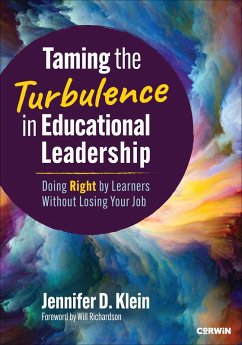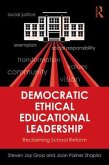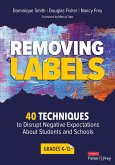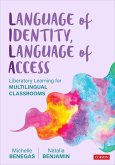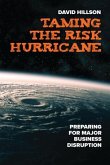Jennifer D Klein
Taming the Turbulence in Educational Leadership
Doing Right by Learners Without Losing Your Job
Jennifer D Klein
Taming the Turbulence in Educational Leadership
Doing Right by Learners Without Losing Your Job
- Broschiertes Buch
- Merkliste
- Auf die Merkliste
- Bewerten Bewerten
- Teilen
- Produkt teilen
- Produkterinnerung
- Produkterinnerung
Learner-centered leadership grounded in courage, integrity, and love for every child The pressures of today's political and cultural climate have created unprecedented roadblocks for school leaders striving to ensure success for all students. With mounting challenges from communities, conservative legislation, and misconceptions about student-centered instruction and inclusion efforts, leaders often feel isolated and threatened in their efforts to prioritize what learners need most. Drawing on interviews with 67 education leaders around the world, Taming the Turbulence in Educational…mehr
Andere Kunden interessierten sich auch für
![Democratic Ethical Educational Leadership Democratic Ethical Educational Leadership]() Steven Jay GrossDemocratic Ethical Educational Leadership54,99 €
Steven Jay GrossDemocratic Ethical Educational Leadership54,99 €![Principal Leadership for Racial Equity Principal Leadership for Racial Equity]() Candace RaskinPrincipal Leadership for Racial Equity45,99 €
Candace RaskinPrincipal Leadership for Racial Equity45,99 €![The Systems Leader The Systems Leader]() Robert E. SiegelThe Systems Leader31,99 €
Robert E. SiegelThe Systems Leader31,99 €![Removing Labels, Grades K-12 Removing Labels, Grades K-12]() Dominique Smith (Health Sciences High and USA Middle College)Removing Labels, Grades K-1241,99 €
Dominique Smith (Health Sciences High and USA Middle College)Removing Labels, Grades K-1241,99 €![Language of Identity, Language of Access Language of Identity, Language of Access]() Michelle BenegasLanguage of Identity, Language of Access37,99 €
Michelle BenegasLanguage of Identity, Language of Access37,99 €![The Age of Turbulence The Age of Turbulence]() Alan GreenspanThe Age of Turbulence23,99 €
Alan GreenspanThe Age of Turbulence23,99 €![Taming the Risk Hurricane Taming the Risk Hurricane]() David HillsonTaming the Risk Hurricane37,99 €
David HillsonTaming the Risk Hurricane37,99 €-
-
-
Learner-centered leadership grounded in courage, integrity, and love for every child The pressures of today's political and cultural climate have created unprecedented roadblocks for school leaders striving to ensure success for all students. With mounting challenges from communities, conservative legislation, and misconceptions about student-centered instruction and inclusion efforts, leaders often feel isolated and threatened in their efforts to prioritize what learners need most. Drawing on interviews with 67 education leaders around the world, Taming the Turbulence in Educational Leadership is a practical handbook, offering strategies to drive equity-focused and student-centered transformation, even in the face of opposition. Additional features include * Approaches to foster trust and build relationships across the campus and community to overcome resistance * Strategies to leverage data; include learner, teacher, and parent voices; and use intentional communication for effective decision-making * Tools for preparing teachers, adapting systems, and protecting staff as they implement equity-centered initiatives * Protocols, reflective questions, and worksheets to help schools determine readiness and create actionable plans Rooted in real-world stories, this book offers solidarity and actionable strategies to education leaders committed to centering the needs of all learners in increasingly polarized societies.
Produktdetails
- Produktdetails
- Verlag: SAGE Publications Inc
- Seitenzahl: 296
- Erscheinungstermin: 5. Dezember 2025
- Englisch
- Abmessung: 253mm x 178mm x 18mm
- Gewicht: 626g
- ISBN-13: 9781071967560
- ISBN-10: 1071967568
- Artikelnr.: 75012335
- Herstellerkennzeichnung
- Libri GmbH
- Europaallee 1
- 36244 Bad Hersfeld
- gpsr@libri.de
- Verlag: SAGE Publications Inc
- Seitenzahl: 296
- Erscheinungstermin: 5. Dezember 2025
- Englisch
- Abmessung: 253mm x 178mm x 18mm
- Gewicht: 626g
- ISBN-13: 9781071967560
- ISBN-10: 1071967568
- Artikelnr.: 75012335
- Herstellerkennzeichnung
- Libri GmbH
- Europaallee 1
- 36244 Bad Hersfeld
- gpsr@libri.de
Jennifer D. Klein is a product of experiential project-based education herself, and she lives and breathes the student-centered pedagogies used to educate her. She became a teacher during graduate school in 1990, quickly finding the intersection between her love of writing and her fascination with educational transformation and its potential impact on social change. She spent nineteen years in the classroom, including several years in Costa Rica and eleven in all-girls education, before leaving the classroom to support educators' professional learning in public, private, and international schools. Motivated by her belief that all children deserve a meaningful, relevant education like the one she experienced herself, and that giving them such an education will catalyze positive change in their communities and beyond, Jennifer strives to inspire educators to shift their practices in schools worldwide. Jennifer is committed to intersecting globally-connected student-centered learning with identity-responsive and anti-racist teaching practices, and her experience includes deep work with schools seeking to address equity, take on brave conversations, build healthier communities, and improve identity politics on campus. She has a broad background in global education and global partnership development, student-centered curricular strategies, diversity and inclusivity work, student-led evaluation, outdoor education, and experiential, inquiry-driven learning. She has facilitated workshops in English and Spanish on four continents, providing the strategies for high-quality, globally connected project-based learning in all cultural and socioeconomic contexts, with an emphasis on amplifying student voice and shifting school culture to support such practices. Jennifer has worked with organizations such as the Buck Institute for Education, the Center for Global Education at the Asia Society, The Institute for International Education, Fulbright Japan, What School Could Be, the Centre for Global Education, TakingITGlobal, and the World Leadership School, to name a few. Most recently, she served as Head of School at Gimnasio Los Caobos (Bogotá, Colombia) for three years, where she was able to put her educational thinking into practice with profound impact on the quality of student learning and their growth as agents of change. Jennifer's first book, The Global Education Guidebook: Humanizing K-12 Classrooms Worldwide Through Equitable Partnerships, was published in 2017, and her second book, The Landscape Model of Learning: Designing Student-Centered Experiences for Cognitive and Cultural Inclusion, coauthored with Kapono Ciotti, was published in 2022. She holds a Bachelor of Arts from Bard College in Annandale-on-Hudson, New York, and a Master of Arts from the University of Colorado at Boulder, both in literature and creative writing. Additionally, Jennifer completed her principal licensing studies at the University of Denver. She currently lives in Denver, Colorado. Learn more about bringing Jennifer to your school or conference at www.principledlearning.org.
Foreword
Acknowledgments
About the Author
Chapter One: Why this, Why Now: An Introduction
Chapter Two: What Schools Are Getting Right, and Why They¿re Meeting
Resistance
Pedagogical and Instructional Innovations That Prioritize Student-Centered
Learning
Innovation in How Schools Define Success
Try This: Unpacking Purpose, Opportunity, and Equity
Innovation and Opportunity for All Learners
The Case of Career Technical Education
The Case of Cognitively and Physically Responsive Education
Innovation Outside the System
Innovation in Academically Driven Schools
Sustained Pedagogical Innovation
Identity-Responsive Learning and Teaching
Culturally Responsive Learning and Teaching in Communities of Color
Culturally Responsive Learning and Teaching in Indigenous Communities
Social-Emotional Learning and Wellness in Schools
Gender and Sexual Identity Inclusion
Critical Thinking, Pluralism, and Intercultural Competency Development
Action Steps
Personal Reflection Questions
Chapter Two Worksheet: Analysis of Context, Readiness for Change, and
(Potential) Pushback
Chapter Three: Relationships and Trust: Build Deep Connection and
Understanding
Seek to Understand Why Community Members Are Resistant
Stay Curious and Avoid Getting Defensive
Try This: Use a "Third Thing" to Reduce Polarization and Build Trust
Encourage Dissent and Invite Dissonance
Cultivate Empathy, Vulnerability, and Open-Mindedness
Manage Pace with an Eye to Building Trust
Go Fast to Serve Students Now
Go Slow and Focus on the "Long Game"
Determine Urgency and Readiness to Establish Pace
Try This: Design a Risk Assessment Matrix to Determine Pace
Create Intentional Structures to Support Relationship Building
Learn and Lead With the Community
Try This: Coffee With the Leader, PBL-Style
Build Systems That Connect and Humanize
Action Steps
Personal Reflection Questions
Chapter Three Worksheet: Build and Maintain Relationships and Trust
Chapter Four: Use Varied Forms of Data to Inform the Journey
Use Quantitative Data to Inform Decisions
Transform Immeasurables and Develop a Shared Understanding
Try This: Use the Y Chart to Turn Squishy Goals Into Observable Metrics
Understand the Dangers (and Inevitable Appeal) of Traditional Metrics
Engage Other Ways of Knowing to Guide the Work
Leverage Street Data and Intuition to See the Bigger Picture
Engage Culturally Relevant Ways of Knowing
Address Religious Ideologies as Cultural Ways of Knowing
Consider a Middle Path that Integrates Traditional and Authentic Data
Action Steps
Personal Reflection Questions
Chapter Four Worksheet: What Are Your Data Sweet Spots?
Chapter Five: The Art of Listening: Leverage Community Voice to Support
Change
Elevate Student Voice to Confront Resistance
Engage Student Voice in Program Development and Governance
Engage Student Voice to Inspire and Educate the Community
Try This: The Student-Centered Insight Protocol
Involve Alumni to Help Motivate Change
Leverage Faculty Allies to Shape Initiatives
Involve Parents and Caregivers as Constructively as Possible
Include Caregiver Input Early in the Change Process
Engage Caregivers as Allies for Change
Action Steps
Personal Reflection Questions
Chapter Five Worksheet: Leverage Community Voice to Shape Initiatives and
Motivate Change
Chapter Six: Communicate with Purpose, on Purpose
Connect Initiatives to "What Makes Us Who We Are"
Connect Work to Your School's Mission, Vision, and Core Values
Validate Where We're Going Through Legislation and School Policy
Change the Words, Not the Work
The DEI Debate and the Dream of a Common Language
Use Language That Fights Gravity
Don't Be Mad, Just Be Ready
Use Proactive (Not Reactive) Communication Focused on the Why
Communicate Early and Often
The "Personal Agenda" and Its Impact on Communication
Consider How (and If) to Communicate Beyond the Schoolhouse
Try This: The Communications Continuum
Action Steps
Personal Reflection Questions
Chapter Six Worksheet: Develop Communication Strategies That Engage With
Purpose and Intentionality
Chapter Seven: Prepare Your People, Protect Your People: Set the Stage for
Success
Provide Transformative Professional Learning for Teachers
Change Minds to Transform the Culture of Learning and Teaching
Lean into Self-Work as Professional Learning
Try This: Principles of Conversational Leadership and Shared Work
Incorporate Live It to Learn It Professional Learning
Utilize Job-Embedded, Collaborative Models for Sustainable Growth
Adapt Systems to Support Innovation and Implementation
Leverage Hiring and Onboarding to Sustain Change
Navigate the Hidden Agenda of Time
Hack Curriculum and Accountability Systems
Embrace Systems That Encourage Risk-Taking
Protect Your People When Opposition Arises
Support Educators With Marginalized Identities
Protect Teachers From External Demands and Restrictions
Build Partnerships With Supervisory Entities
Protect the Community From More Significant Harm
Try This: The After Action Review
Action Steps
Personal Reflection Questions
Chapter Seven Worksheet: Plan for Implementation That Prepares, Adapts, and
Protects
Chapter Eight: Lead With Humility, Courage, and Hope: Final Lessons From
Leaders
You Are Not an Island
Build Supportive Teams and Networks Inside the School
Engage Consultants, Coaches, and Experts
Contracting Experts: A Cautionary Tale
Leverage Support Organizations, Networks, and Cooperatives
Lean on Excellent Educational Institutions
Try This: Concentric Circles to Map Institutional Visits
Leadership Is a Journey
Prioritize Well-Being for Everyone, Including Yourself
Don't Let the Storm Hurt Your Resolve
Let Go of What No Longer Serves Your Community
Try This: Stop, Start, Continue, Restart
Celebrate Every Success
Hope Is a Verb that Invites Action
Focus on Your Locus of Control
Embrace Diverse Perspectives (Even When It's Hard)
Try This: Reflect on Wheatley's "Lessons From Besieged Nuns"
Plant Seeds for the Future
Action Steps
Personal Reflection Questions
Chapter Eight Worksheet: Prepare for the Journey Ahead
Interview Participants
Recommended Reading from Educational Leaders
References
Index
Acknowledgments
About the Author
Chapter One: Why this, Why Now: An Introduction
Chapter Two: What Schools Are Getting Right, and Why They¿re Meeting
Resistance
Pedagogical and Instructional Innovations That Prioritize Student-Centered
Learning
Innovation in How Schools Define Success
Try This: Unpacking Purpose, Opportunity, and Equity
Innovation and Opportunity for All Learners
The Case of Career Technical Education
The Case of Cognitively and Physically Responsive Education
Innovation Outside the System
Innovation in Academically Driven Schools
Sustained Pedagogical Innovation
Identity-Responsive Learning and Teaching
Culturally Responsive Learning and Teaching in Communities of Color
Culturally Responsive Learning and Teaching in Indigenous Communities
Social-Emotional Learning and Wellness in Schools
Gender and Sexual Identity Inclusion
Critical Thinking, Pluralism, and Intercultural Competency Development
Action Steps
Personal Reflection Questions
Chapter Two Worksheet: Analysis of Context, Readiness for Change, and
(Potential) Pushback
Chapter Three: Relationships and Trust: Build Deep Connection and
Understanding
Seek to Understand Why Community Members Are Resistant
Stay Curious and Avoid Getting Defensive
Try This: Use a "Third Thing" to Reduce Polarization and Build Trust
Encourage Dissent and Invite Dissonance
Cultivate Empathy, Vulnerability, and Open-Mindedness
Manage Pace with an Eye to Building Trust
Go Fast to Serve Students Now
Go Slow and Focus on the "Long Game"
Determine Urgency and Readiness to Establish Pace
Try This: Design a Risk Assessment Matrix to Determine Pace
Create Intentional Structures to Support Relationship Building
Learn and Lead With the Community
Try This: Coffee With the Leader, PBL-Style
Build Systems That Connect and Humanize
Action Steps
Personal Reflection Questions
Chapter Three Worksheet: Build and Maintain Relationships and Trust
Chapter Four: Use Varied Forms of Data to Inform the Journey
Use Quantitative Data to Inform Decisions
Transform Immeasurables and Develop a Shared Understanding
Try This: Use the Y Chart to Turn Squishy Goals Into Observable Metrics
Understand the Dangers (and Inevitable Appeal) of Traditional Metrics
Engage Other Ways of Knowing to Guide the Work
Leverage Street Data and Intuition to See the Bigger Picture
Engage Culturally Relevant Ways of Knowing
Address Religious Ideologies as Cultural Ways of Knowing
Consider a Middle Path that Integrates Traditional and Authentic Data
Action Steps
Personal Reflection Questions
Chapter Four Worksheet: What Are Your Data Sweet Spots?
Chapter Five: The Art of Listening: Leverage Community Voice to Support
Change
Elevate Student Voice to Confront Resistance
Engage Student Voice in Program Development and Governance
Engage Student Voice to Inspire and Educate the Community
Try This: The Student-Centered Insight Protocol
Involve Alumni to Help Motivate Change
Leverage Faculty Allies to Shape Initiatives
Involve Parents and Caregivers as Constructively as Possible
Include Caregiver Input Early in the Change Process
Engage Caregivers as Allies for Change
Action Steps
Personal Reflection Questions
Chapter Five Worksheet: Leverage Community Voice to Shape Initiatives and
Motivate Change
Chapter Six: Communicate with Purpose, on Purpose
Connect Initiatives to "What Makes Us Who We Are"
Connect Work to Your School's Mission, Vision, and Core Values
Validate Where We're Going Through Legislation and School Policy
Change the Words, Not the Work
The DEI Debate and the Dream of a Common Language
Use Language That Fights Gravity
Don't Be Mad, Just Be Ready
Use Proactive (Not Reactive) Communication Focused on the Why
Communicate Early and Often
The "Personal Agenda" and Its Impact on Communication
Consider How (and If) to Communicate Beyond the Schoolhouse
Try This: The Communications Continuum
Action Steps
Personal Reflection Questions
Chapter Six Worksheet: Develop Communication Strategies That Engage With
Purpose and Intentionality
Chapter Seven: Prepare Your People, Protect Your People: Set the Stage for
Success
Provide Transformative Professional Learning for Teachers
Change Minds to Transform the Culture of Learning and Teaching
Lean into Self-Work as Professional Learning
Try This: Principles of Conversational Leadership and Shared Work
Incorporate Live It to Learn It Professional Learning
Utilize Job-Embedded, Collaborative Models for Sustainable Growth
Adapt Systems to Support Innovation and Implementation
Leverage Hiring and Onboarding to Sustain Change
Navigate the Hidden Agenda of Time
Hack Curriculum and Accountability Systems
Embrace Systems That Encourage Risk-Taking
Protect Your People When Opposition Arises
Support Educators With Marginalized Identities
Protect Teachers From External Demands and Restrictions
Build Partnerships With Supervisory Entities
Protect the Community From More Significant Harm
Try This: The After Action Review
Action Steps
Personal Reflection Questions
Chapter Seven Worksheet: Plan for Implementation That Prepares, Adapts, and
Protects
Chapter Eight: Lead With Humility, Courage, and Hope: Final Lessons From
Leaders
You Are Not an Island
Build Supportive Teams and Networks Inside the School
Engage Consultants, Coaches, and Experts
Contracting Experts: A Cautionary Tale
Leverage Support Organizations, Networks, and Cooperatives
Lean on Excellent Educational Institutions
Try This: Concentric Circles to Map Institutional Visits
Leadership Is a Journey
Prioritize Well-Being for Everyone, Including Yourself
Don't Let the Storm Hurt Your Resolve
Let Go of What No Longer Serves Your Community
Try This: Stop, Start, Continue, Restart
Celebrate Every Success
Hope Is a Verb that Invites Action
Focus on Your Locus of Control
Embrace Diverse Perspectives (Even When It's Hard)
Try This: Reflect on Wheatley's "Lessons From Besieged Nuns"
Plant Seeds for the Future
Action Steps
Personal Reflection Questions
Chapter Eight Worksheet: Prepare for the Journey Ahead
Interview Participants
Recommended Reading from Educational Leaders
References
Index
Foreword
Acknowledgments
About the Author
Chapter One: Why this, Why Now: An Introduction
Chapter Two: What Schools Are Getting Right, and Why They¿re Meeting
Resistance
Pedagogical and Instructional Innovations That Prioritize Student-Centered
Learning
Innovation in How Schools Define Success
Try This: Unpacking Purpose, Opportunity, and Equity
Innovation and Opportunity for All Learners
The Case of Career Technical Education
The Case of Cognitively and Physically Responsive Education
Innovation Outside the System
Innovation in Academically Driven Schools
Sustained Pedagogical Innovation
Identity-Responsive Learning and Teaching
Culturally Responsive Learning and Teaching in Communities of Color
Culturally Responsive Learning and Teaching in Indigenous Communities
Social-Emotional Learning and Wellness in Schools
Gender and Sexual Identity Inclusion
Critical Thinking, Pluralism, and Intercultural Competency Development
Action Steps
Personal Reflection Questions
Chapter Two Worksheet: Analysis of Context, Readiness for Change, and
(Potential) Pushback
Chapter Three: Relationships and Trust: Build Deep Connection and
Understanding
Seek to Understand Why Community Members Are Resistant
Stay Curious and Avoid Getting Defensive
Try This: Use a "Third Thing" to Reduce Polarization and Build Trust
Encourage Dissent and Invite Dissonance
Cultivate Empathy, Vulnerability, and Open-Mindedness
Manage Pace with an Eye to Building Trust
Go Fast to Serve Students Now
Go Slow and Focus on the "Long Game"
Determine Urgency and Readiness to Establish Pace
Try This: Design a Risk Assessment Matrix to Determine Pace
Create Intentional Structures to Support Relationship Building
Learn and Lead With the Community
Try This: Coffee With the Leader, PBL-Style
Build Systems That Connect and Humanize
Action Steps
Personal Reflection Questions
Chapter Three Worksheet: Build and Maintain Relationships and Trust
Chapter Four: Use Varied Forms of Data to Inform the Journey
Use Quantitative Data to Inform Decisions
Transform Immeasurables and Develop a Shared Understanding
Try This: Use the Y Chart to Turn Squishy Goals Into Observable Metrics
Understand the Dangers (and Inevitable Appeal) of Traditional Metrics
Engage Other Ways of Knowing to Guide the Work
Leverage Street Data and Intuition to See the Bigger Picture
Engage Culturally Relevant Ways of Knowing
Address Religious Ideologies as Cultural Ways of Knowing
Consider a Middle Path that Integrates Traditional and Authentic Data
Action Steps
Personal Reflection Questions
Chapter Four Worksheet: What Are Your Data Sweet Spots?
Chapter Five: The Art of Listening: Leverage Community Voice to Support
Change
Elevate Student Voice to Confront Resistance
Engage Student Voice in Program Development and Governance
Engage Student Voice to Inspire and Educate the Community
Try This: The Student-Centered Insight Protocol
Involve Alumni to Help Motivate Change
Leverage Faculty Allies to Shape Initiatives
Involve Parents and Caregivers as Constructively as Possible
Include Caregiver Input Early in the Change Process
Engage Caregivers as Allies for Change
Action Steps
Personal Reflection Questions
Chapter Five Worksheet: Leverage Community Voice to Shape Initiatives and
Motivate Change
Chapter Six: Communicate with Purpose, on Purpose
Connect Initiatives to "What Makes Us Who We Are"
Connect Work to Your School's Mission, Vision, and Core Values
Validate Where We're Going Through Legislation and School Policy
Change the Words, Not the Work
The DEI Debate and the Dream of a Common Language
Use Language That Fights Gravity
Don't Be Mad, Just Be Ready
Use Proactive (Not Reactive) Communication Focused on the Why
Communicate Early and Often
The "Personal Agenda" and Its Impact on Communication
Consider How (and If) to Communicate Beyond the Schoolhouse
Try This: The Communications Continuum
Action Steps
Personal Reflection Questions
Chapter Six Worksheet: Develop Communication Strategies That Engage With
Purpose and Intentionality
Chapter Seven: Prepare Your People, Protect Your People: Set the Stage for
Success
Provide Transformative Professional Learning for Teachers
Change Minds to Transform the Culture of Learning and Teaching
Lean into Self-Work as Professional Learning
Try This: Principles of Conversational Leadership and Shared Work
Incorporate Live It to Learn It Professional Learning
Utilize Job-Embedded, Collaborative Models for Sustainable Growth
Adapt Systems to Support Innovation and Implementation
Leverage Hiring and Onboarding to Sustain Change
Navigate the Hidden Agenda of Time
Hack Curriculum and Accountability Systems
Embrace Systems That Encourage Risk-Taking
Protect Your People When Opposition Arises
Support Educators With Marginalized Identities
Protect Teachers From External Demands and Restrictions
Build Partnerships With Supervisory Entities
Protect the Community From More Significant Harm
Try This: The After Action Review
Action Steps
Personal Reflection Questions
Chapter Seven Worksheet: Plan for Implementation That Prepares, Adapts, and
Protects
Chapter Eight: Lead With Humility, Courage, and Hope: Final Lessons From
Leaders
You Are Not an Island
Build Supportive Teams and Networks Inside the School
Engage Consultants, Coaches, and Experts
Contracting Experts: A Cautionary Tale
Leverage Support Organizations, Networks, and Cooperatives
Lean on Excellent Educational Institutions
Try This: Concentric Circles to Map Institutional Visits
Leadership Is a Journey
Prioritize Well-Being for Everyone, Including Yourself
Don't Let the Storm Hurt Your Resolve
Let Go of What No Longer Serves Your Community
Try This: Stop, Start, Continue, Restart
Celebrate Every Success
Hope Is a Verb that Invites Action
Focus on Your Locus of Control
Embrace Diverse Perspectives (Even When It's Hard)
Try This: Reflect on Wheatley's "Lessons From Besieged Nuns"
Plant Seeds for the Future
Action Steps
Personal Reflection Questions
Chapter Eight Worksheet: Prepare for the Journey Ahead
Interview Participants
Recommended Reading from Educational Leaders
References
Index
Acknowledgments
About the Author
Chapter One: Why this, Why Now: An Introduction
Chapter Two: What Schools Are Getting Right, and Why They¿re Meeting
Resistance
Pedagogical and Instructional Innovations That Prioritize Student-Centered
Learning
Innovation in How Schools Define Success
Try This: Unpacking Purpose, Opportunity, and Equity
Innovation and Opportunity for All Learners
The Case of Career Technical Education
The Case of Cognitively and Physically Responsive Education
Innovation Outside the System
Innovation in Academically Driven Schools
Sustained Pedagogical Innovation
Identity-Responsive Learning and Teaching
Culturally Responsive Learning and Teaching in Communities of Color
Culturally Responsive Learning and Teaching in Indigenous Communities
Social-Emotional Learning and Wellness in Schools
Gender and Sexual Identity Inclusion
Critical Thinking, Pluralism, and Intercultural Competency Development
Action Steps
Personal Reflection Questions
Chapter Two Worksheet: Analysis of Context, Readiness for Change, and
(Potential) Pushback
Chapter Three: Relationships and Trust: Build Deep Connection and
Understanding
Seek to Understand Why Community Members Are Resistant
Stay Curious and Avoid Getting Defensive
Try This: Use a "Third Thing" to Reduce Polarization and Build Trust
Encourage Dissent and Invite Dissonance
Cultivate Empathy, Vulnerability, and Open-Mindedness
Manage Pace with an Eye to Building Trust
Go Fast to Serve Students Now
Go Slow and Focus on the "Long Game"
Determine Urgency and Readiness to Establish Pace
Try This: Design a Risk Assessment Matrix to Determine Pace
Create Intentional Structures to Support Relationship Building
Learn and Lead With the Community
Try This: Coffee With the Leader, PBL-Style
Build Systems That Connect and Humanize
Action Steps
Personal Reflection Questions
Chapter Three Worksheet: Build and Maintain Relationships and Trust
Chapter Four: Use Varied Forms of Data to Inform the Journey
Use Quantitative Data to Inform Decisions
Transform Immeasurables and Develop a Shared Understanding
Try This: Use the Y Chart to Turn Squishy Goals Into Observable Metrics
Understand the Dangers (and Inevitable Appeal) of Traditional Metrics
Engage Other Ways of Knowing to Guide the Work
Leverage Street Data and Intuition to See the Bigger Picture
Engage Culturally Relevant Ways of Knowing
Address Religious Ideologies as Cultural Ways of Knowing
Consider a Middle Path that Integrates Traditional and Authentic Data
Action Steps
Personal Reflection Questions
Chapter Four Worksheet: What Are Your Data Sweet Spots?
Chapter Five: The Art of Listening: Leverage Community Voice to Support
Change
Elevate Student Voice to Confront Resistance
Engage Student Voice in Program Development and Governance
Engage Student Voice to Inspire and Educate the Community
Try This: The Student-Centered Insight Protocol
Involve Alumni to Help Motivate Change
Leverage Faculty Allies to Shape Initiatives
Involve Parents and Caregivers as Constructively as Possible
Include Caregiver Input Early in the Change Process
Engage Caregivers as Allies for Change
Action Steps
Personal Reflection Questions
Chapter Five Worksheet: Leverage Community Voice to Shape Initiatives and
Motivate Change
Chapter Six: Communicate with Purpose, on Purpose
Connect Initiatives to "What Makes Us Who We Are"
Connect Work to Your School's Mission, Vision, and Core Values
Validate Where We're Going Through Legislation and School Policy
Change the Words, Not the Work
The DEI Debate and the Dream of a Common Language
Use Language That Fights Gravity
Don't Be Mad, Just Be Ready
Use Proactive (Not Reactive) Communication Focused on the Why
Communicate Early and Often
The "Personal Agenda" and Its Impact on Communication
Consider How (and If) to Communicate Beyond the Schoolhouse
Try This: The Communications Continuum
Action Steps
Personal Reflection Questions
Chapter Six Worksheet: Develop Communication Strategies That Engage With
Purpose and Intentionality
Chapter Seven: Prepare Your People, Protect Your People: Set the Stage for
Success
Provide Transformative Professional Learning for Teachers
Change Minds to Transform the Culture of Learning and Teaching
Lean into Self-Work as Professional Learning
Try This: Principles of Conversational Leadership and Shared Work
Incorporate Live It to Learn It Professional Learning
Utilize Job-Embedded, Collaborative Models for Sustainable Growth
Adapt Systems to Support Innovation and Implementation
Leverage Hiring and Onboarding to Sustain Change
Navigate the Hidden Agenda of Time
Hack Curriculum and Accountability Systems
Embrace Systems That Encourage Risk-Taking
Protect Your People When Opposition Arises
Support Educators With Marginalized Identities
Protect Teachers From External Demands and Restrictions
Build Partnerships With Supervisory Entities
Protect the Community From More Significant Harm
Try This: The After Action Review
Action Steps
Personal Reflection Questions
Chapter Seven Worksheet: Plan for Implementation That Prepares, Adapts, and
Protects
Chapter Eight: Lead With Humility, Courage, and Hope: Final Lessons From
Leaders
You Are Not an Island
Build Supportive Teams and Networks Inside the School
Engage Consultants, Coaches, and Experts
Contracting Experts: A Cautionary Tale
Leverage Support Organizations, Networks, and Cooperatives
Lean on Excellent Educational Institutions
Try This: Concentric Circles to Map Institutional Visits
Leadership Is a Journey
Prioritize Well-Being for Everyone, Including Yourself
Don't Let the Storm Hurt Your Resolve
Let Go of What No Longer Serves Your Community
Try This: Stop, Start, Continue, Restart
Celebrate Every Success
Hope Is a Verb that Invites Action
Focus on Your Locus of Control
Embrace Diverse Perspectives (Even When It's Hard)
Try This: Reflect on Wheatley's "Lessons From Besieged Nuns"
Plant Seeds for the Future
Action Steps
Personal Reflection Questions
Chapter Eight Worksheet: Prepare for the Journey Ahead
Interview Participants
Recommended Reading from Educational Leaders
References
Index

